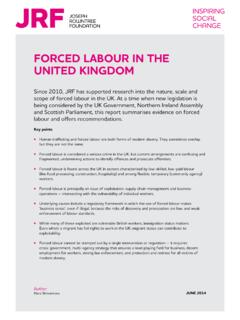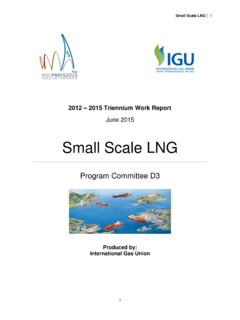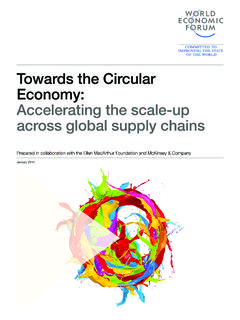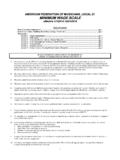Transcription of The Nature and Scale of Labour Exploitation across …
1 1 | P a g e 194 Information of a sensitive Nature has been redacted from this document. PROBLEM PROFILE The Nature and Scale of Labour Exploitation across all Sectors within the United Kingdom 2 | P a g e Executive Summary .. 3 Aim and Purpose .. 4 Introduction .. 4 International Context .. 5 National Overview .. 6 Victims of Labour Exploitation in the United Kingdom .. 7 Offenders of Labour Exploitation in the United Kingdom .. 13 Methodology From Recruitment to Exploitation .. 13 Sector Analysis .. 18 Horizon Scanning .. 28 Glossary of Terms .. 31 Table of Contents 3 | P a g e The prevalence of Labour Exploitation is difficult to accurately measure. However, an increasing number of suspected cases are being reported.
2 The UK is described as being one of the main destinations of trafficked workers in Europe, and Labour Exploitation was recorded as the most frequent type of Exploitation for both adults and minors in the UK in 2016 and 2017 according to National Referral Mechanism (NRM) data. The NRM was introduced in 2009 and is a framework for identifying victims of human trafficking and/or modern slavery and ensuring they receive support. NRM referral data shows that the number of Vietnamese potential victims is consistently high and continues to increase. In 2017; Vietnamese, British and Albanian were the most common nationalities referred for Labour Exploitation . In contrast, GLAA intelligence indicates that Exploitation of Romanian workers is most frequently reported.
3 It is important to note that NRM data for Labour Exploitation includes criminal Exploitation , for example cannabis cultivation. There is often a correlation between the nationality of potential victims and exploiters; they may share a common language or cultural similarities which facilitates recruitment and control. British suspects appear more readily prepared to exploit victims from other backgrounds and who are already present in the UK. The criminal business process used by potential exploiters is not judged to have changed significantly over the past twelve months. Workers in several sectors may be erroneously labelled as self-employed, meaning they have little or no workplace rights, for example statutory benefits such as sick pay.
4 Effective enforcement of Labour regulations will protect workers against exploitative recruitment and employment practices. Efforts have been made to protect potential victims of Exploitation at the UK border, however, offenders continue to find means and routes by which to transport victims into the UK. The impact of Britain leaving the EU is, at present, unknown despite it being the predominant factor likely to have a bearing upon the intelligence picture over the coming years. Current assessments so far are unclear as to how this will look for the Labour market and GLAA intelligence does not yet identify a change in how criminals, businesses and potential victims will operate. Executive Summary 4 | P a g e The purpose of this report is to provide an update to the original The Nature and Scale of Labour Exploitation across all Sectors within the United Kingdom report produced and disseminated in November 2016.
5 This report will provide an updated assessment of the threats previously identified in 2016, newly emerging trends in 2017, and a forecast of possible threats into 2018. This will in turn help to inform GLAA and partner agency decision making processes and focus resources on the areas at greatest risk both at strategic and operational level. This problem profile has been produced using data from the National Referral Mechanism (NRM), intelligence and operational information held within the GLAA and open source information. Modern slavery is an umbrella term encompassing slavery, servitude, forced or compulsory Labour and human trafficking. Victims of modern slavery are unable to leave their situation of Exploitation , controlled by threats, punishment, violence, coercion and deception.
6 Slavery violates human rights, denying people of their right to life, freedom and security. Globally it is estimated that there are over 40 million people living in slavery with in excess of over 13,000 potential victims of trafficking in the UK1, though this is believed to be a conservative estimate. Taking action against human trafficking and modern slavery continues to be a top priority for the UK government. The Prime Minister s Modern Slavery Taskforce has driven forward the operational response to modern slavery in the UK and positioned modern slavery as a key component of the UK s foreign policy2. The UK is considered to be in the top ten governments globally with the strongest response to modern slavery3. The Modern Slavery Act 2015 and the Immigration Act 2016 provided a greater national focus on Labour Exploitation .
7 Under the Immigration Act, the GLAA gained new powers to investigate Labour market offences in England and Wales from the 30th April 2017. The GLAA now have a broader role in terms of addressing Labour Exploitation , with additional consideration as to how a consistent enforcement approach in Scotland and Northern Ireland can be delivered. There are over 1,000 licensed gangmasters based in both the UK and overseas who supply as many as 464,000 temporary contracted workers in the regulated sector. The GLAA has a single overarching aim: Working in partnership to protect vulnerable and exploited workers . This aim will be achieved by maintaining a continual focus on three strategic priorities: Preventing worker Exploitation Protecting vulnerable people Pursuing those who exploit others for their work either financially, physically and / or through coercion and control.
8 Over the next two years the GLAA will engage in three specific areas of work which will all be achieved in partnership to: Prevent workers from being exploited for their Labour Protect workers and potential victims so making them less vulnerable to being exploited for their Labour 1 [Accessed 22nd November 2017] 2 HM Government, 2017 UK Annual report on Modern Slavery (October 2017) page 2 3 [Accessed 23rd November 2017] Aim and Purpose Introduction 5 | P a g e Pursue relentlessly, disrupting and prosecuting those who engage in the Exploitation of workers4. The prevalence of human trafficking, and specifically forced Labour , at an international, national and local level is difficult to accurately assess due to the hidden Nature of the threat.
9 However, data quality and recording is improving, which has enabled several reports to provide estimates for its Scale . Globally it has been estimated that there are over 40 million people living in slavery, including almost 25 million in forced Labour of which 16 million are in the private economy. In the past five years, approximately 89 million people will have experienced some form of modern slavery for periods of time ranging from a few days to years. Slavery is a global issue and is believed to be most prevalent in Africa, followed by Asia and the Pacific5. Poverty is also a factor in making people vulnerable to Exploitation ; reports suggest that almost half of the world s population lives on the equivalent of approximately $2 per day6 and in much of Europe there has been long-term unemployment, youth unemployment and risk of poverty7.
10 As such, there is a substantial potential victim base, particularly for Labour Exploitation . According to the United Nations Office on Drugs and Crime (UNODC), over the past ten years, the proportion of victims trafficked for forced Labour globally has increased, with approximately 40% of all victims detected between 2012 and 2014 being trafficked for forced labour8. Forced Labour is assessed to be most prevalent in Asia and the Pacific, followed by Europe and Central Asia. Globally, over 70% of adults forced to work in agriculture, domestic work or manufacturing are in debt bondage9. Within the Western and Southern European region, the most frequently detected form of Exploitation is sexual Exploitation , though trafficking for forced Labour is highlighted as being of increasing significance and represents approximately 30% of exploitation10.






